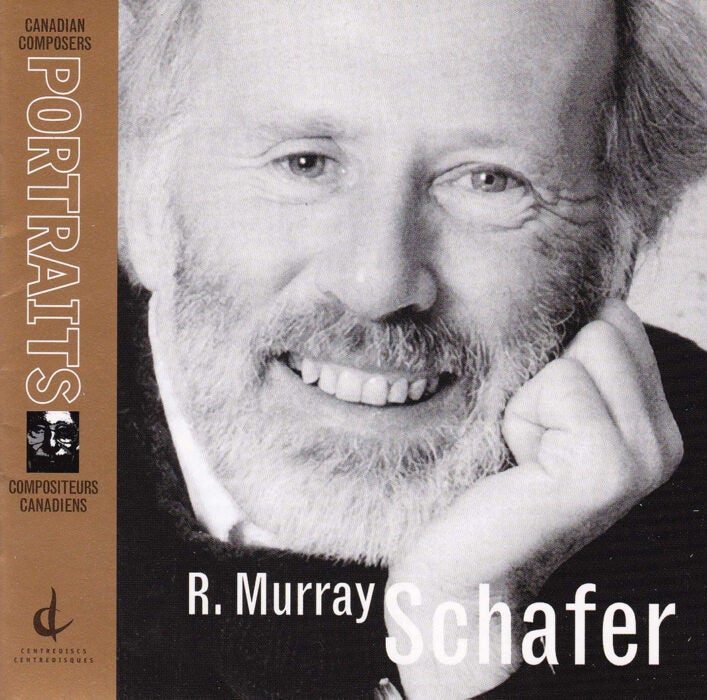If you’ve ever used the word “soundscape,” you owe a small debt to the late Canadian composer R. Murray Schafer. You can repay that debt by simply taking the opportunity to listen—and doing so in an “openly attentive” manner, as Schafer put it in his 1969 book, The New Soundscape.
Let’s try that. First, grab a pencil and a piece of paper—or, if you must, unlock your cell phone—so you can itemize the sounds that you will proceed to identify. Now, take a sonic inventory. Here’s Schafer’s instruction: “Sit quietly for a moment and receive.”
Perhaps you’ll hear a passing car or plane, the wind, HVAC, your stomach grumbling, birdsong, a distant dog’s bark, the scratching (or clicking) of your note-taking-in-progress, the drone of the refrigerator, a neighbor’s vacuum cleaner, some ambiguous reverberation that you can’t quite place, or the whispers of people nearby wondering why you’re staring into space.
Allot ten minutes for this task. The first minute or two should pass quickly; after that, your listening may increase in difficulty. You’ll likely experience extended periods when you think that you hear nothing additional, and then you’ll hear beyond what you’ve already heard, past the seeming silence, and in turn you’ll locate more sounds. These sounds you’ve heard will come and go, and they’ll change over time. Note each one.
Weekly Newsletter
When the ten minutes have passed, look over your list. Think about the sounds not as individual incidents but instead as interconnected aspects of a larger environmental reality. Ask yourself what clusters of related themes they form: Near versus far? Pleasant versus disagreeable? Interior versus exterior? Natural versus human-made? Figurative versus abstract? Music versus noise?
That web of connections is the foundation of what we have come to call the soundscape—in Schafer’s words, a “macrocosmic musical composition,” or the manner in which a variety of happenstance sounds at a given moment collectively have a cohesive sensibility, one inferred by the listener and resulting from a variety of environmental and cultural forces.

While the term soundscape is colloquial today, that universality exists precisely because we’ve come to take it for granted. A peek at Google’s ever-helpful Ngram Viewer shows how relatively recent its arrival was. The word soundscape was essentially a linguistic nonentity until the late 1960s. Then it took off, steadily at first, soon after astronomically.
In terms of milestones charting the word’s rise, Schafer’s The New Soundscape, which was billed as “A Handbook for the Modern Music Teacher,” coalesced research he had undertaken until then. Almost a decade later, in 1977, he published The Tuning of the World, his major work, which further reified the word, such that the book was eventually retitled by its publisher to capitalize on the term’s increased popularity. The Tuning of the World became: The Soundscape: Our Sonic Environment and the Tuning of the World. (And 1969’s The New Soundscape became the “old” one.)
At the time, in Scientific American, the 1977 volume was praised as “an analysis and a manifesto—learned, witty, crisp.” The journal Musical Quarterly recognized that Schafer’s book, seemingly at first about the social science of sound and the regulation of noise pollution, could be read at “an even deeper, philosophical level.” The New York Times claimed that “the original sections will raise your consciousness of the soundscape to a level of sensitivity you never experienced before. Quietly, Mr. Schafer makes us realize how much noise matters.”
Today a soundscape can take many forms. Fundamentally, it’s that assemblage of sounds around us at a given time in a given place, with an emphasis on those that are, in some way, “true” to the place and time—consistent, inherent, even unique—such as the singular characteristics of a church’s bells, a mosque’s unique call to prayer, native birdsong, the echo of a specific canyon, the noise of a manufacturing site. The soundscape has particular meaning in ecology, by which the health of an environment can be gauged by its sonic aspects, much as it can by soil, water, or air quality. The term soundscape has become denuded—or, if you want to be generous, more inclusive—to serve as a catchall for generic washes of placeless, ambient sound in meditation apps and sleep-aid gadgetry. And, of course, there are the artificial soundscapes that are part of the worldbuilding in video games, television, and movies.
So, who is R. Murray Schafer, and how did this simple, ubiquitous term, soundscape, come to be?
By the time The New Soundscape was published, Schafer, then in his mid-30s, had established himself as a contemporary composer. He was born in 1933 in Sarnia, on the Ontario side of the border with Michigan. After education at the Royal Conservatory of Music in Toronto, and later in Europe, he began teaching at Simon Fraser University in British Columbia. It was around the publication of The New Soundscape that his interests in listening and environmentalism manifested in the creation of the World Soundscape Project.
Beginning at a local scale, focused on the city of Vancouver, the project sought to “discover principles and develop techniques by which the social, psychological, and aesthetic quality of the acoustic environment or soundscape may be improved,” per Schafer’s fellow composer and World Soundscape Project member Barry Truax. As their efforts and the implications grew, the word soundscape became the centerpiece for all manner of activities. As philosophical as The Tuning of the World can be, it also engages with regulatory bodies. It traces the history of noise ordinances in Bern, Switzerland, back to 1628, when a by-law was introduced “against singing and shouting in streets or houses on festival days.” The book likewise compares abatement legislation around the world by a variety of factors, including distinctions between qualitative and quantitative criteria.
There is something of a Cambrian explosion to the people and concepts, books and music, that came out of the World Soundscape Project. In addition to Schafer and Truax, other notable early members included such varied talents as John Oswald, best known for his manic sampling techniques, and Hildegard Westerkamp, who weaves field recordings into her compositions. An entire field, “acoustic ecology,” developed to, among other things, measure and mediate the impact of sound on the environment.
The term soundscape itself draws, self-evidently, from the idea of a “landscape,” the varied elements that define a broad environmental location—in this case sonic rather than visual. Schafer had a penchant for neologisms; they didn’t all take off. The concept of a “soundmark” (“a community sound which is unique or possesses qualities which make it specially regarded or noticed by the people in that community,” per The Tuning of the World) has purpose within such fields as ethnomusicology, urban studies, and acoustic ecology. However, neither it nor another Schaferism, “schizophonia” (the manner by which, thanks to technology, we “have split the sound from the makers of the sound,” per The New Soundscape), have captured the imagination of the general public on a scale anywhere approaching soundscape.
Schafer’s notion of the soundscape has not evaded criticism or amendment. His environmental perspective, for example, took shape in an overt favoring of the natural over the human. In that formulation, civilization could be framed as a threat to nature, and that threat needed to be addressed—even reversed. There is a fantastic set of conversations from a 2021 podcast with associates and critics of Schafer, moderated by Mack Hagood, in which they discuss his complicated legacy.
Emily Thompson describes the situation in her 2002 book, The Soundscape of Modernity: Architectural Acoustics and the Culture of Listening in America, 1900–1933, arguing that “Schafer defined a soundscape as a sonic environment, a definition that reflected his engagement with the environmental movements of the 1970s and emphasized his ecologically based concern about the ‘polluted’ nature of the soundscape of that era.”
Thompson notes her own preference for the perspective of French historian Alain Corbin, a Schafer contemporary. “A soundscape, like a landscape, ultimately has more to do with civilization than with nature, and as such, it is constantly under construction and always undergoing change,” Thompson writes. Human presence in the soundscape is thus not inherently something to be corrected for. Steven Feld, also emphasizing the human element, has extended the idea of the soundscape with the concept of “acoustemology,” derived from phenomenology; in the words of Matt Sakakeeny, it “explore[s] the interrelations between sound, place, and culture.”
What none of that valuable work does is eradicate the soundscape as an essential tool in comprehending the world around us through the act of considered listening. Instead, it builds upon and recalibrates the lattice that Schafer helped erect in the first place. And if we acknowledge Schafer’s disgruntlement with industrialization, we should also note when he bends in the other direction. In one of the most memorable passages of The Tuning of the World, he places humans at the very center of the matter, writing that “the best way to comprehend what I mean by acoustic design is to regard the soundscape of the world as a huge musical composition, unfolding around us ceaselessly. We are simultaneously its audience, its performers, and its composers.”
It seems fitting that a person who defined such a widely used word should also come to have his own holiday. Each July 18, marking Schafer’s birthday, is World Listening Day, initiated by the World Listening Project back in 2010. (Schafer died in August 2021 at age eighty-eight.) The annual event “aims to raise awareness about the significance of listening as a cultural practice and promotes sonic stewardship of the environment,” per the organization’s website. Every year a different theme helps focus participants’ listening; this year, the theme is “Listening to the Weave of Time,” as proposed by the Chilean sound art collective AOIR, which consists of Valentina Villarroel Ambiado and Camila Cijka Arzola.
From its initial publication in 1977, Schafer’s The Tuning of the World was a transformative book across disciplines. One reviewer, a biology professor writing in the journal Human Ecology, took issue with Schafer’s more “mystical” provocations regarding the soundscape and his casual writing style. Nevertheless, the professor deemed the volume “a monumental work. Read it, and your life will not be the same.” He then proceeded to describe how, over a holiday break, still under Schafer’s fresh spell, he found himself instinctively cataloging and considering the sounds around him.
“The public’s education can begin with this book,” he concluded. And so it did.







